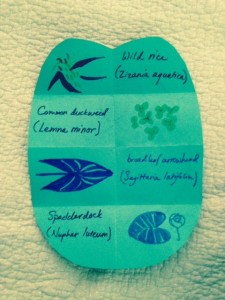Description: Paper turtle shell or paper butterfly folded into sections for students’ reference drawings of plants at John Heinz National Wildlife Refuge
Objectives:
1. Familiarization and ability to identify some plants at JHNWR.
2. Knowledge of symmetry in organisms.
3. Both creative and scientific depiction of different plants and animals.
Author: Blair
Grade level or Target Age Range:Elementary to middle school
Sample, Historical Art Examples, and References:
project sample:
Vocabulary: Bilateral symmetry, names of plants, radial symmetry, balance, approximate
Materials: Construction paper, scissors, and markers, crayons or color pencils
Anticipatory Set: Organisms are all vastly different. What traits do they have in common? Show photos of animal faces, human faces, butterflies, and turtles. Symmetry is big part of how organisms have evolved on this planet. Symmetry is also a good way to organize information, like a book!
Demo/Directions:
1. Show examples of bilateral and radial symmetry. Then show finished project sample. Demonstrate cutting out turtle or butterfly shape.
(5-10 minutes)
2. Demonstrate folding into 6 or 8 sections (6 for butterflies, 8 for turtles). Then display reference photos for plants (wild rice, duckweed, arrowhead, and spadderdock).
(10 minutes)
3. Demonstrate drawing basic shapes of plants on alternate sections of folded butterfly or turtle shell, leaving a space on the left or right of each drawing for the plant’s name. Emphasize that plant drawings can be any color and the shape can be approximate. Help any individual students as needed.
(15-20 minutes)
4. Display names for each plant next to reference photos, so students can write them next to their own drawings (can be common name, scientific name, or both).
(10 minutes)
5. Students have done their biological work! Have fun showing how butterflies and turtles move by demonstrating with finished projects.
6. Share any necessary clean-up.
(5 minutes)





